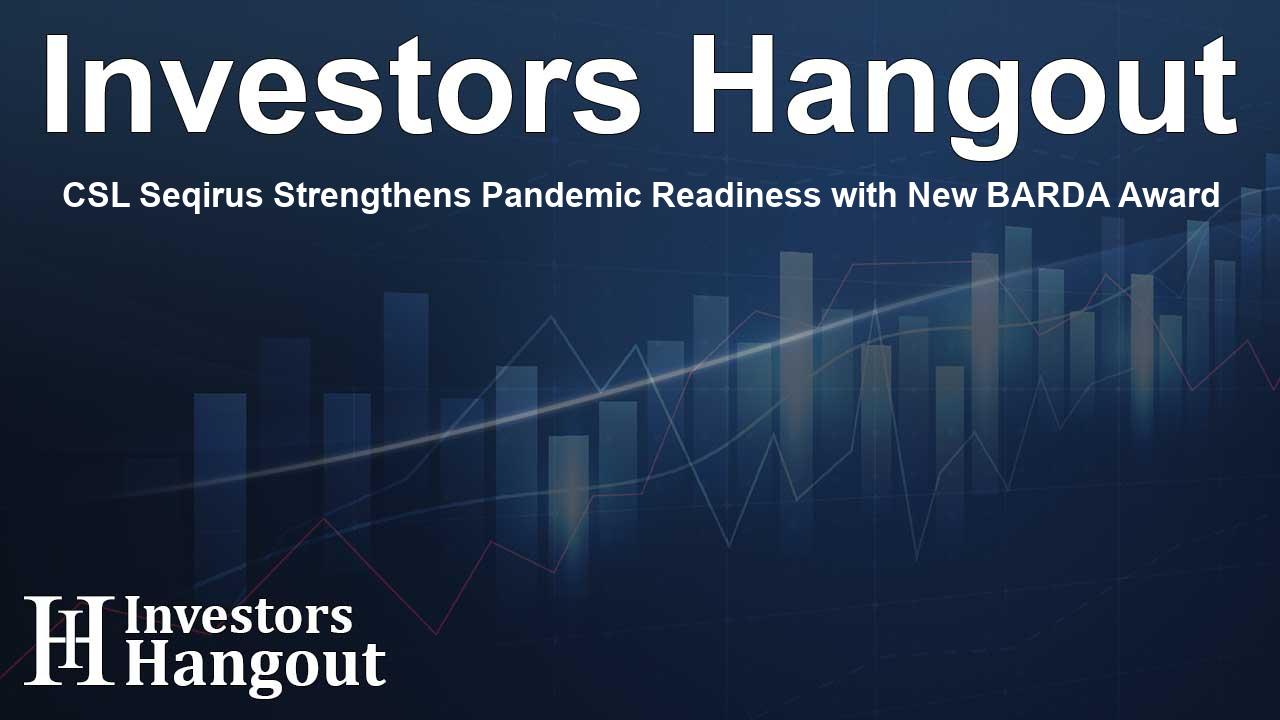CSL Seqirus Strengthens Pandemic Readiness with New BARDA Award

CSL Seqirus Receives Significant BARDA Award
CSL Seqirus has recently received a noteworthy award from the Biomedical Advanced Research and Development Authority (BARDA). This grant is aimed at furthering the company's capabilities in preparing for potential pandemic situations through the development of avian influenza vaccines. The need for preparedness in public health is more pertinent now than ever, and this award underscores the commitment of CSL Seqirus to global health security.
Details of the BARDA Partnership
The latest investment from BARDA, amounting to $34 million, marks the sixth award received by CSL Seqirus as a part of its ongoing efforts to combat avian influenza. These funds will support the fill-and-finish process of additional pre-pandemic vaccine doses. In particular, BARDA is seeking adjuvanted H5N1 pre-pandemic vaccines, as well as more H5N8 antigen, highlighting an expansion in their proactive approach to pandemic preparedness.
Importance of Avian Influenza Vaccines
Avian influenza poses a significant risk to global health, and CSL Seqirus is at the forefront of developing effective vaccines to counteract potential outbreaks. The company's work is vital for the national stockpile of vaccines, which aims to ensure rapid deployment in response to future challenges. This grant will facilitate the production of approximately 3 million finished doses of the H5N1 vaccine, reflecting the strategic investments that are crucial to mitigating pandemic risks.
Global Collaboration in Health Security
As emphasized by Marc Lacey, Global Executive Director for Pandemic at CSL Seqirus, collaborative efforts are essential in tackling health threats on a global scale. The company's dedication to working alongside over thirty governments showcases its importance as a trusted partner in pandemic preparedness. This partnership enhances the capability to respond swiftly to emerging health challenges, reinforcing the idea that collective action leads to better health outcomes.
Innovations in Vaccine Production
CSL Seqirus's Holly Springs manufacturing facility is a testament to their commitment to innovation and scalability in production. This facility, recognized as the largest cell-based influenza vaccine producer in the world, is meticulously designed to respond swiftly to pandemic threats. With capabilities to produce 150 million doses within six months of a pandemic declaration, the plant is well-positioned to support public health initiatives effectively.
Commitment to Ongoing Research and Development
The company’s approach is not just focused on immediate responses, but also on sustained research and development. Ongoing activities include maintaining seed libraries, raw material stockpiles, and a comprehensive understanding of various influenza strains that could pose future risks. This readiness ensures that CSL Seqirus can activate expansive production capabilities as needed.
Understanding Pandemic Influenza Risks
Pandemic influenza presents unique challenges, including a lack of pre-existing immunity in the population. With past pandemics highlighting the severe impacts influenza can have globally, the emphasis on preparedness has never been more critical. CSL Seqirus's proactive measures aim to reduce morbidity and mortality associated with potential outbreaks.
About CSL Seqirus
CSL Seqirus, a business of CSL, is globally recognized for its innovative approaches to public health. With advanced production facilities across the U.S., U.K., and Australia, the company provides a diverse portfolio of vaccines designed to prevent infectious diseases such as influenza and COVID-19. Their commitment is not only to produce vaccines but also to ensure that these solutions are available when needed most by populations around the world.
Frequently Asked Questions
What is the significance of the BARDA award for CSL Seqirus?
The BARDA award supports CSL Seqirus in enhancing pandemic preparedness through the development and production of avian influenza vaccines.
How many doses is CSL Seqirus expected to produce?
CSL Seqirus plans to deliver approximately 3 million finished doses of the H5N1 pre-pandemic vaccine as part of this award.
What role does collaboration play in pandemic preparedness?
Collaboration enhances the capability to address health threats effectively, as evidenced by CSL Seqirus's partnerships with numerous governments worldwide.
Where is the main manufacturing facility located?
The main manufacturing facility of CSL Seqirus is located in Holly Springs, North Carolina, and it is designed to support rapid vaccine production.
What innovations does CSL Seqirus bring to the field of vaccine production?
CSL Seqirus employs a scalable method of production at its facilities, capable of producing millions of doses quickly to meet public health needs during a pandemic.
About The Author
Contact Addison Perry privately here. Or send an email with ATTN: Addison Perry as the subject to contact@investorshangout.com.
About Investors Hangout
Investors Hangout is a leading online stock forum for financial discussion and learning, offering a wide range of free tools and resources. It draws in traders of all levels, who exchange market knowledge, investigate trading tactics, and keep an eye on industry developments in real time. Featuring financial articles, stock message boards, quotes, charts, company profiles, and live news updates. Through cooperative learning and a wealth of informational resources, it helps users from novices creating their first portfolios to experts honing their techniques. Join Investors Hangout today: https://investorshangout.com/
The content of this article is based on factual, publicly available information and does not represent legal, financial, or investment advice. Investors Hangout does not offer financial advice, and the author is not a licensed financial advisor. Consult a qualified advisor before making any financial or investment decisions based on this article. This article should not be considered advice to purchase, sell, or hold any securities or other investments. If any of the material provided here is inaccurate, please contact us for corrections.
